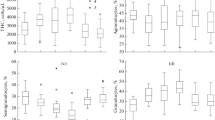Summary
H. modestus, a water-snake with morphological respiratory adaptation to its habitat, presents haemoglobins with a lower Bohr effect than those ofL. miliaris, an aquatic snake without such respiratory adaptations. The difference in blood lactic acid content of the 2 snakes submitted to mechanical stimuli appears to be compatible with the properties of their haemoglobins.
Similar content being viewed by others
Literatur
S. H. Ogo, A. S. Abe and A. Focesi, Jr, Comp. Biochem. Physiol., in press.
E. P. Marbach and M. H. Weil, Clin. Chem.13, 314 (1967).
G. W. Schwert, D. B. S. Millar and Y. Takenaka, J. biol. Chem.237, 2131 (1962).
B. Sullivan, Science157, 1308 (1967).
Author information
Authors and Affiliations
Additional information
Suported in part by FAPESP-Proc. 76/1338
Rights and permissions
About this article
Cite this article
Ogo, S.H., Focesi, A. Haemoglobin Bohr effect and lactic acid content of the blood of 2 water-snakes with different degrees of aquatic adaptation. Experientia 35, 862–863 (1979). https://doi.org/10.1007/BF01955113
Published:
Issue Date:
DOI: https://doi.org/10.1007/BF01955113



